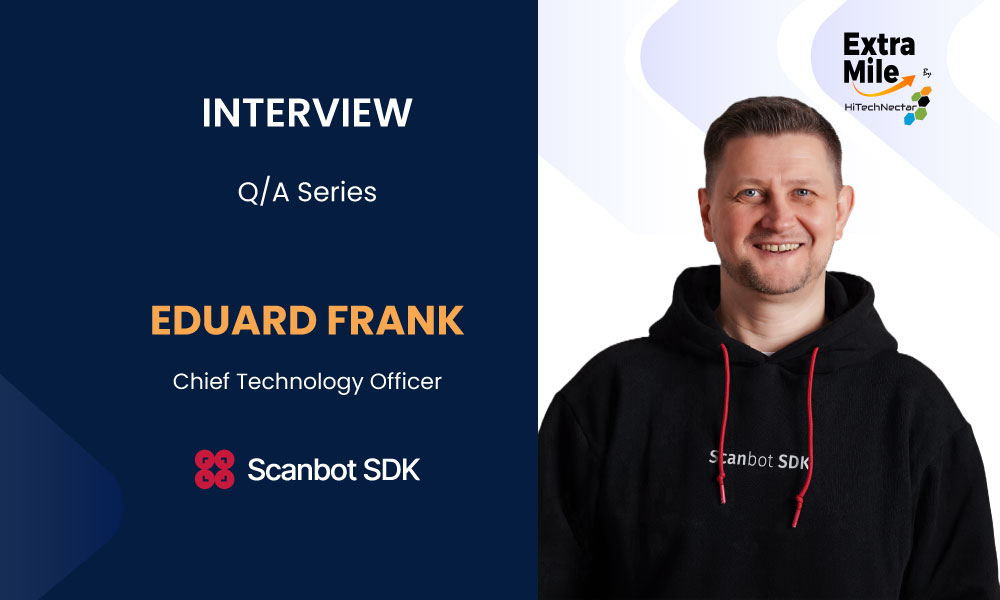Welcome to ExtraMile by HiTechNectar, an exclusive interview series where industry leaders discuss innovations, tech trends, marketing tactics, and expert insights.
Discover the secrets of innovation in scanning and data extraction with Eduard Frank, the Chief Technology Officer of leading technology firm, Scanbot SDK. The company builds the fastest, most accurate, and reliable mobile data capture solutions for mobile apps or websites.
Frank’s seven-year journey in the company, from technical team lead to the company’s CTO, is impressive and linear. Let’s dive into his journey so far, alongside exploring data security, barcode, and document scanning while understanding the significance of strong collaborations.
Hello Eduard! Greetings for the day! We are excited to host you today!
Q1. As a core techie, how do you see different technologies evolving over the years, and how have these helped address complex tasks lately?
Ans. At Scanbot SDK, our focus is on mobile technology. Its evolution over the past two decades has been remarkable, particularly in smartphone cameras and processing power.
We’ve capitalized on these advances by developing SDKs that turn smartphones into enterprise-grade barcode and document scanners. We use machine learning and computer vision technology to leverage the raw capabilities of smartphones and build sophisticated scanning solutions.
Our technology enables businesses to tackle complex tasks without specialized hardware, whether that’s inventory management in warehouses or document digitization for insurers.
Q2. You have been associated with Scanbot SDK for more than seven years now, during which the company has achieved significant growth. How have you led the company to stay technologically ahead, and what key strategies have you incorporated to attain your goals?
Ans. Our growth has been driven by a systematic, team-based approach. For the core software, our machine learning engineers are constantly pushing the boundaries of ML and computer vision, keeping us on the cutting edge.
Our mobile teams use these core models to build versatile wrappers for a range of platforms, from Android, iOS, and cross-platform to web, Windows, and Linux. That makes it very easy to integrate our SDKs.
Then, our QA team thoroughly tests these solutions to ensure our customers get high-quality and bug-free software.
And of course, our Customer Success team connects our engineering teams and our customers. They’re responsible for providing immediate support and for passing feedback and requests back to our developers.
Q3. Why barcode scanning, document scanning, and data extraction are important. How do you ensure these facilities remain fast and user-friendly in your company?
Ans. Businesses have to digitize analog data to work efficiently. With good barcode scanning, document scanning, and data extraction tools, they can automate data entry and streamline document processing. These are crucial prerequisites for a modern inventory management system, for example.
With our user-centric approach to cutting-edge technology, we ensure that our solutions are not only capable, but also accessible. Our machine learning team continually refines algorithms for speed and accuracy, while our development teams work with UX specialists to create intuitive interfaces.
Combining performance with ease-of-use is what allows organizations to fully utilize these technologies in their daily operations, saving time, reducing errors, and increasing overall productivity.
Q4. Scanbot SDK has recently achieved the milestone of scanning 26 barcodes per second. This is a great achievement for the company as well as its tech team. Do you see this achievement as an opportunity to set future goals for the company?
Ans. This speed is impressive even to me, and I am proud of the team for achieving it. Our primary goal, though, is to ensure that the barcode scanner performs consistently under all conditions. Whether it’s low light, damaged codes, or varying distances, we want our scanner to always work flawlessly. These are the factors that make a real difference in our customers’ day-to-day operations. Real-world scenarios don’t typically need scanning speeds that high, and we’re not actively working on making scanning even faster.
However, the speed is an excellent indicator of our scanner’s reliability. The ability to accurately decode fast-moving, blurry images demonstrates just how robust our technology is. That’s crucial for ensuring scan quality in a wide range of conditions.
Q5. Scanbot SDK’s ability to offer services without an internet connection is quite impressive. How have you designed your product to operate offline, and what technical innovations make this possible?
Ans. The idea behind our offline functionality is simple: We don’t use servers to scan barcodes. Instead, we run our trained models directly on the device. This means we’re using on-device intelligence to scan barcodes right from the camera stream.
We can do this because of the processing power of smartphones. Even older devices can easily handle the scanning process, because we’ve made our SDK incredibly lightweight. Eliminating the need for an internet connection during scanning has big advantages: It doesn’t just ensure reliable performance, it also improves user privacy by design.
Q6. According to you, what is the role of data security in today’s tech-driven world? What specific measures do you look after to prioritize data security?
Ans. Data security is critical, especially in industries that handle sensitive information such as healthcare and insurance. Our design philosophy reflects this: Because our SDK processes all data directly on the user’s device, we eliminate many typical security risks. There’s no transmission of sensitive data to external servers during scanning.
While the further handling and transmission of the scanned data is outside our direct responsibility, we’ve built encryption capabilities into our SDK to prepare that data for secure transmission. This allows our customers to easily integrate our scanning capabilities into their own workflows and build secure, compliant solutions in their industries.
Q7. Partnerships and collaborations are essential for business growth. How do you ensure your offerings align with your client’s requirements? Do you believe in tailoring your services in this regard?
Ans. We highly value long-term partnerships and maintain an ongoing dialogue with our customers. We consider their feedback very carefully when planning our product roadmap. However, we balance this input with our own expertise and vision.
While we stay true to our core technology, we strive to evolve our offering to meet changing market needs. This approach allows us to maintain the high quality and reliability of our products while ensuring that they remain relevant and valuable to our customer base.
Explore Our Other Insightful Interviews:





















